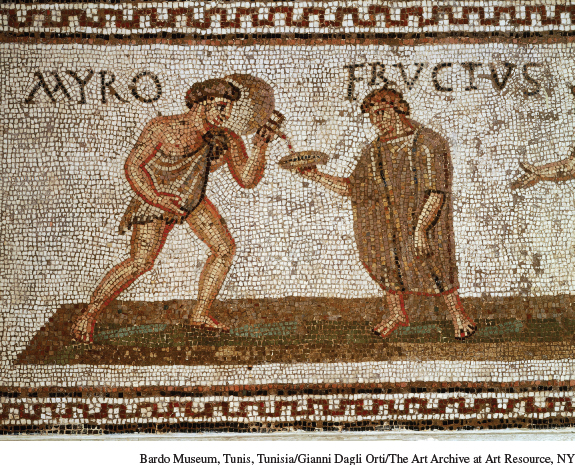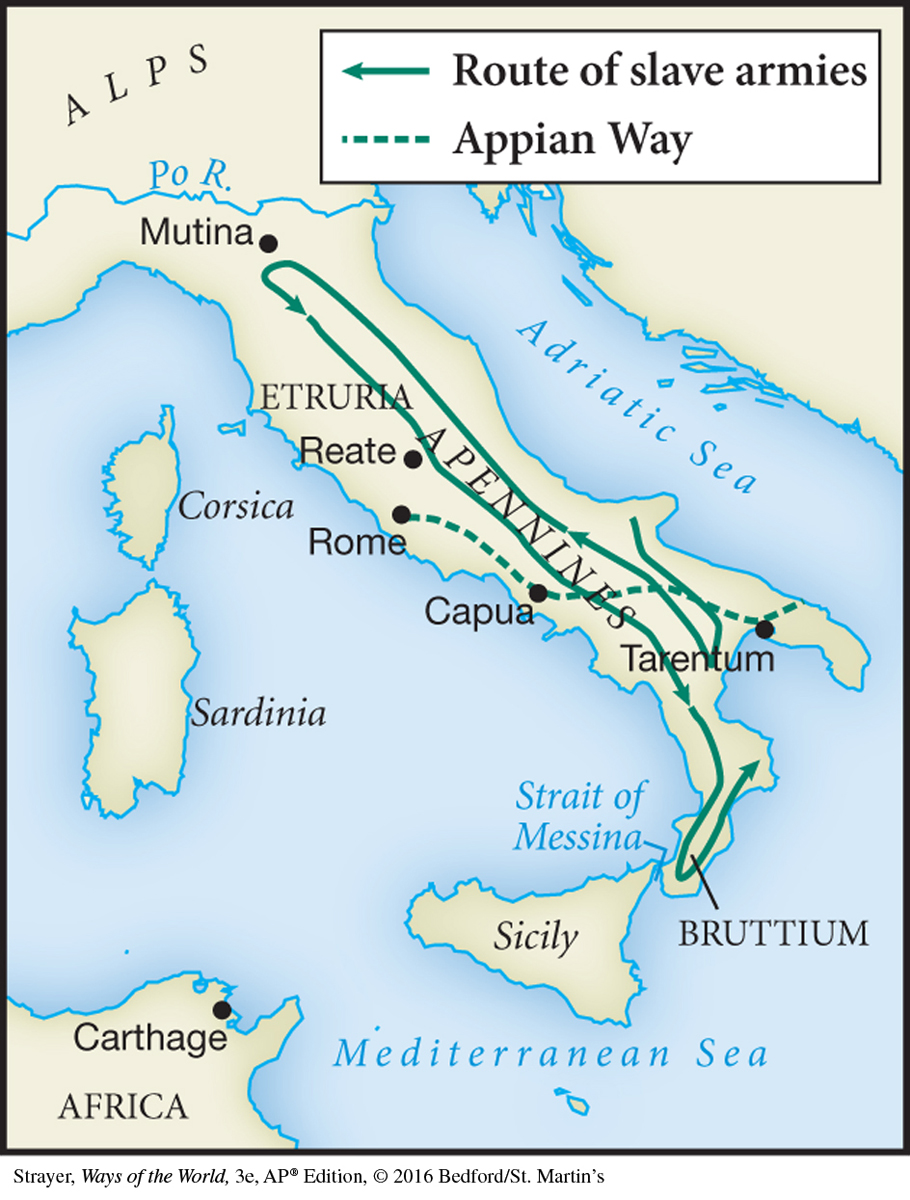The Making of Roman Slavery
Guided Reading Question
▪COMPARISON
How did Greco-
In sharp contrast to other second-

“The ancient Greek attitude toward slavery was simple,” writes one modern scholar. “It was a terrible thing to become a slave, but a good thing to own a slave.”9 Even poor households usually had at least one or two female slaves, providing domestic work and sexual services for their owners. Although substantial numbers of Greek slaves were granted freedom by their owners, they usually did not become citizens or gain political rights. Nor could they own land or marry citizens, and particularly in Athens they had to pay a special tax. Their status remained “halfway between slavery and freedom.”10
Practiced on an even larger scale, slavery was a defining element of Roman society. By the time of Christ, the Italian heartland of the Roman Empire had some 2 to 3 million slaves, representing 33 to 40 percent of the population.11 Not until the modern slave societies of the Caribbean, Brazil, and the southern United States was slavery practiced again on such an enormous scale. Wealthy Romans could own many hundreds or even thousands of slaves. One woman in the fifth century C.E. freed 8,000 slaves when she withdrew into a life of Christian monastic practice. Even people of modest means frequently owned two or three slaves. In doing so, they confirmed their own position as free people, demonstrated their social status, and expressed their ability to exercise power. Slaves and former slaves also might be slave owners. One freedman during the reign of Augustus owned 4,116 slaves at the time of his death. (See Working with Evidence: Pompeii as a Window on the Roman World.)
The vast majority of Roman slaves had been prisoners captured in the many wars that accompanied the creation of the empire. In 146 B.C.E., following the destruction of the North African city of Carthage, some 55,000 people were enslaved en masse. From all over the Mediterranean basin, men and women were funneled into the major slave-owning regions of Italy and Sicily. Pirates also furnished slaves, kidnapping tens of thousands and selling them to Roman slave traders on the island of Delos. Roman merchants purchased still other slaves through networks of long-distance commerce extending to the Black Sea, the East African coast, and northwestern Europe. The supply of slaves also occurred through natural reproduction, as the children of slave mothers were regarded as slaves themselves. Such “home-born” slaves had a certain prestige and were thought to be less troublesome than those who had known freedom earlier in their lives. Finally, abandoned or exposed children could legally become the slave of anyone who rescued them.
Unlike American slavery of later times, Roman practice was not identified with a particular racial or ethnic group. Egyptians, Syrians, Jews, Greeks, Gauls, North Africans, and many other people found themselves alike enslaved. From within the empire and its adjacent regions, an enormous diversity of people were bought and sold at Roman slave markets.
Like slave owners everywhere, Romans regarded their slaves as “barbarians” — lazy, unreliable, immoral, prone to thieving — and came to think of certain peoples, such as Asiatic Greeks, Syrians, and Jews, as slaves by nature. Nor was there any serious criticism of slavery in principle, although on occasion owners were urged to treat their slaves in a more benevolent way. Even the triumph of Christianity within the Roman Empire did little to undermine slavery, for Christian teaching held that slaves should be “submissive to [their] masters with all fear, not only to the good and gentle, but also to the harsh.”12 In fact, the New Testament used the metaphor of slavery to describe the relationship of believers to God, styling them as “slaves of Christ,” while Saint Augustine (354–430 C.E.) described slavery as God’s punishment for sin. Thus slavery was deeply embedded in the religious thinking and social outlook of elite Romans.
Similarly, slavery was entrenched throughout the Roman economy. No occupation was off-limits to slaves except military service, and no distinction existed between jobs for slaves and those for free people. Frequently they labored side by side. In rural areas, slaves provided much of the labor force on the huge estates, or latifundia, which produced grain, olive oil, and wine, mostly for export, much like the later plantations in the Americas. There they often worked chained together. In the cities, slaves worked in their owners’ households, but also as skilled artisans, teachers, doctors, business agents, entertainers, and actors. In the empire’s many mines and quarries, slaves and criminals labored under brutal conditions. Slaves in the service of the emperor provided manpower for the state bureaucracy, maintained temples and shrines, and kept Rome’s water supply system functioning. Trained in special schools, they also served as gladiators in the violent spectacles of Roman public life. Female slaves usually served as domestic servants but were also put to work in brothels, served as actresses and entertainers, and could be used sexually by their male owners. Thus slaves were represented among the highest and most prestigious occupations and in the lowest and most degraded.
AP® EXAM TIP
Know examples of slave rebellions and their effects.
Slave owners in the Roman Empire were supposed to provide the necessities of life to their slaves. When this occurred, slaves may have had a more secure life than was available to impoverished free people, who had to fend for themselves, but the price of this security was absolute subjection to the will of the master. Beatings, sexual abuse, and sale to another owner were constant possibilities. Lacking all rights in the law, slaves could not legally marry, although many contracted unofficial unions. Slaves often accumulated money or possessions, but such property legally belonged to their masters and could be seized at any time. If a slave murdered his master, Roman law demanded the lives of all of the victim’s slaves. When one Roman official was killed by a slave in 61 C.E., every one of his 400 slaves was condemned to death. For an individual slave, the quality of life depended almost entirely on the character of the master. Brutal owners made life a living hell. Benevolent owners made life tolerable and might even grant favored slaves their freedom or permit them to buy that freedom. As in Greece, manumission of slaves was a widespread practice, and in the Roman Empire, unlike in Greece, freedom was accompanied by citizenship.

Roman slaves, like their counterparts in other societies, responded to enslavement in many ways. Most, no doubt, did what was necessary to survive, but there are recorded cases of Roman prisoners of war who chose to commit mass suicide rather than face the horrors of slavery. Others, once enslaved, resorted to the “weapons of the weak” — small-scale theft, sabotage, pretending illness, working poorly, and placing curses on their masters. Fleeing to the anonymous crowds of the city or to remote rural areas prompted owners to post notices in public places, asking for information about their runaways. Catching runaway slaves became an organized private business. Occasional murders of slave owners made masters conscious of the dangers they faced. “Every slave we own is an enemy we harbor” ran one Roman saying.13
On several notable occasions, the slaves themselves rose in rebellion. The most famous uprising occurred in 73 B.C.E. when a slave gladiator named Spartacus led seventy other slaves from a school for gladiators in a desperate bid for freedom that mushroomed into a huge uprising. (See Zooming In: The Spartacus Slave Revolt for a more detailed account.) Nothing on the scale of Spartacus’s rebellion occurred again in the Western world of slavery until the Haitian Revolution of the 1790s. But Haitian rebels sought the creation of a new society free of slavery altogether. None of the Roman slave rebellions, including that of Spartacus, had any such overall plan or goal. The rebels simply wanted to escape Roman slavery. Although rebellions created a perpetual fear in the minds of slave owners, slavery itself was hardly affected.